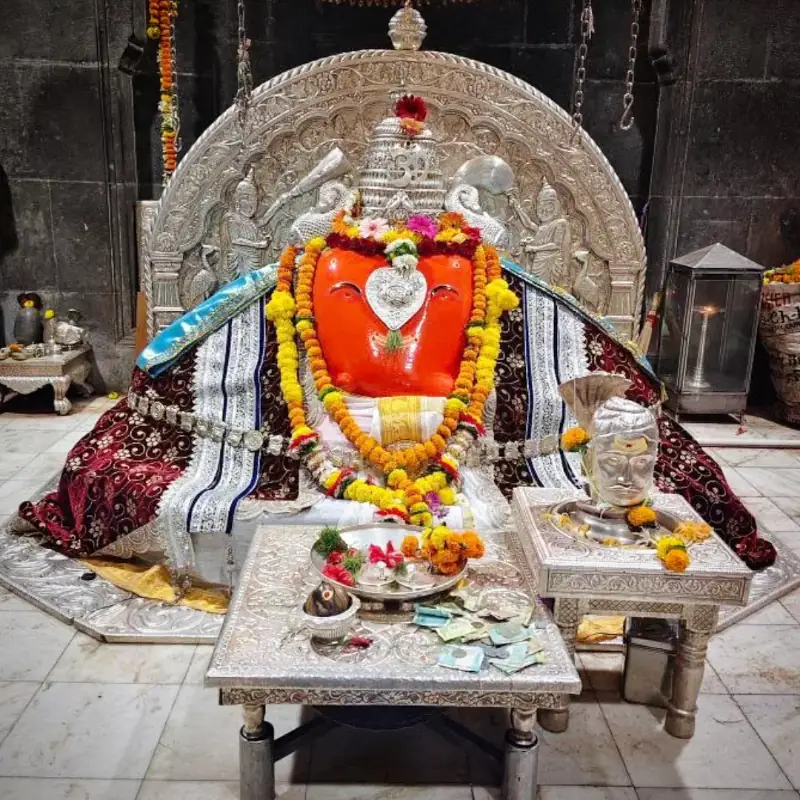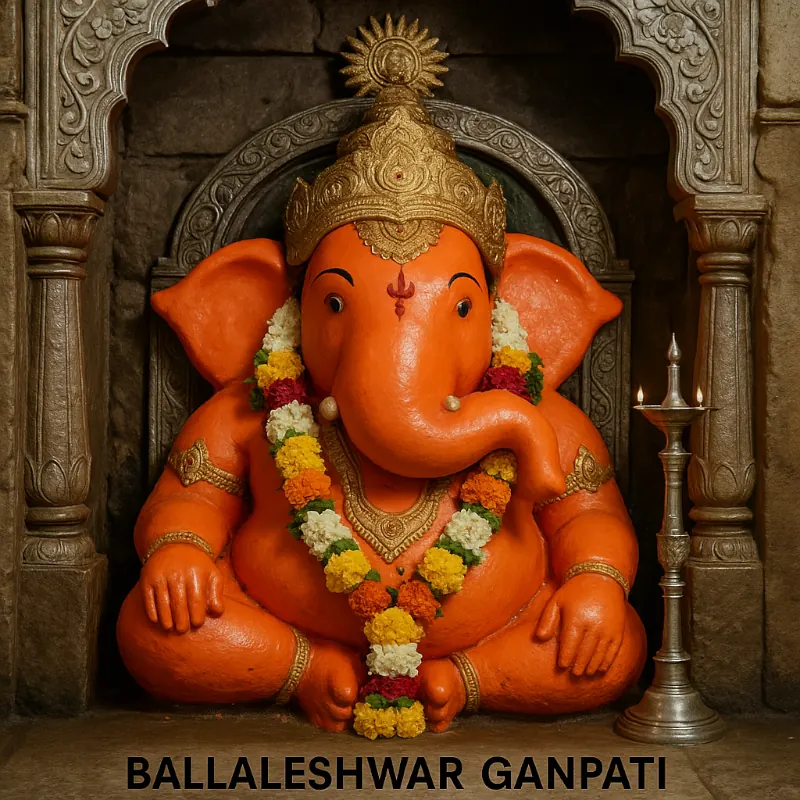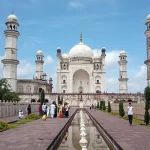“Where Devotion Meets Legacy: Discover the Sacred Saga of Ballaleshwar Ganpati”
“Ready to embark on a spiritual journey? Book your trip to Ballaleshwar Temple and experience divine blessings. Share your pilgrimage story with us!”
🔴 Introduction:
🔘 The Legend and Legacy of Ballaleshwar
Nestled in the quaint village of Pali, Raigad district, the Ballaleshwar Ganpati Temple stands as a testament to unwavering devotion. Unlike other Ashtavinayak temples, this shrine uniquely bears the name of its devotee, Ballal, a boy whose love for Lord Ganesha moved the deity to reside here eternally.
🔘 A Tale of Faith and Redemption
Centuries ago, young Ballal’s intense worship of a stone idol angered his father, Kalyan, who destroyed the sacred site. Bound to a tree and left to perish, Ballal’s cries summoned Lord Ganesha, who healed him and vowed to stay as Ballaleshwar – “Lord of Ballal”. This story of divine intervention forms the temple’s spiritual core, attracting devotees seeking solace and miracles.
Also Read
Aurangabad Caves – A Hidden Gem of Maharashtra
🔘 Architectural Brilliance
Built in 1760 by Nana Fadnavis, the temple blends Hemadpanthi and Konkani styles. Its east-facing sanctum is designed so sunrise rays illuminate the idol daily. Key features include:
👉 Shri-shaped layout with lead-infused stone walls.
👉 Two sanctums: The inner chamber houses the 15-foot idol with diamond-studded eyes, while the outer sanctum features a rat holding Modak.
👉 Eight cypress-shaped pillars symbolising cosmic directions.
🔘 Cultural Significance
Ballaleshwar is the Third Temple in the Ashtavinayak circuit. Pilgrims first worship Dhundi Vinayak, the original idol discarded by Ballal’s father, before proceeding to the main shrine. The temple’s Besan Laddu Prasad and grand Bhadrapadi Utsav procession highlight its cultural vibrancy.

🛕 Ballaleshwar Ganpati Temple: Divine Pilgrimage Guide
🟢 Detailed Introduction:
🕉️ Ballaleshwar Ganpati Temple, Pali – The Ashtavinayak Shrine Where Divinity Embraces Devotion
Nestled amid the lush Sahyadri hills and the serene Amba River in Maharashtra’s Raigad district, the Ballaleshwar Ganpati Temple stands as a spiritual beacon in the sacred Ashtavinayak circuit. Unlike its seven counterparts, this temple holds a unique distinction: it is the only one where Lord Ganesha is worshipped not by his divine title but by the name of his ardent child-devotee, Ballal. This extraordinary bond between deity and disciple forms the soul of the temple, making it a symbol of unwavering faith and divine grace.
The temple’s origin is steeped in a poignant legend from the Krita Yuga (Satya Yuga), as recounted in the Ganesh Purana and Mudgal Purana. Ballal, the son of a wealthy merchant named Kalyan, was no ordinary child. While his peers indulged in play, he led groups of children into the forests of Pali to worship stone idols of Ganesha. His devotion, however, enraged his father, who saw it as a distraction.
In a fit of fury, Kalyan destroyed the idol, bound Ballal to a tree, and abandoned him. Yet, the child’s unyielding prayers summoned Lord Ganesha himself, who healed Ballal’s wounds and vowed to reside eternally in Pali as Ballaleshwar — the “Lord of Ballal”. This tale of redemption and grace echoes through the temple’s corridors, drawing pilgrims seeking solace and miracles.

Architecturally, the temple is a marvel of 18th-century ingenuity. Commissioned in 1760 by Nana Fadnavis, the shrewd statesman of the Maratha Empire, it replaced an older wooden structure with a stone edifice designed in the sacred ‘Shri’ shape, a configuration believed to channel cosmic energy. The temple’s walls, infused with lead for durability, withstand the test of time, while its east-facing sanctum is meticulously aligned so that the first rays of dawn illuminate the idol’s diamond-studded eyes — a celestial spectacle that epitomises the harmony of science and spirituality.
At the heart of the temple lies the Self-manifested (Swayambhu) Idol of Ballaleshwar, carved from a single stone. The deity sits in a meditative pose, his trunk curled left, against a shimmering silver backdrop adorned with carvings of Siddhi (spiritual power) and Riddhi (Prosperity). The idol’s eyes, embedded with diamonds, exude an ethereal gaze, while the outer sanctum houses a rare idol of a rat—Ganesha’s Vahana—holding a Modak, symbolising the fulfilment of devotees’ desires. This duality of inner and outer shrines reflects the temple’s layered spiritual symbolism.
The temple’s geography further enhances its mystique. Flanked by the historic Sarasgad Fort and the tranquil Amba River, Pali is a confluence of natural beauty and cultural heritage. The region’s Konkani roots are evident in the temple’s design, which blends Hemadpanthi Architecture with local Konkan styles. Two ancient lakes, Rama Kund and Laxmi Kund, border the complex, their waters used in rituals and believed to possess healing properties. For centuries, these elements have intertwined to create an aura of sacred serenity.
Ballaleshwar’s rituals are a vibrant tapestry of devotion. Daily Aartis begin at 5:30 AM, with the rhythmic chants of “Sukhakarta Dukhaharta” resonating through the halls. The temple’s annual Bhadrapadi Utsav, held during the Hindu month of Bhadrapada (August–September), transforms Pali into a carnival of faith.

A grand Palakhi (Palanquin) procession weaves through the village, accompanied by folk dances, Lezim performances, and the distribution of Besan laddu Prasad. During Maghi Utsav (January), scholars narrate episodes from the Ganesh Purana, bridging mythology and modernity.
What truly sets Ballaleshwar apart is its Dhundi Vinayak shrine — a lesser-known sanctum housing the original stone idol shattered by Ballal’s father. Pilgrims worship here first, acknowledging the fragment’s role in the temple’s genesis, before proceeding to the main deity. This practice underscores a profound lesson: even brokenness can become a gateway to divinity.
Beyond its spiritual allure, the temple is a cultural microcosm. Local Konkani traditions thrive in its shadow—artisans craft clay Ganesha idols for festivals, while village kitchens serve Ukdiche Modak and Puran Poli. Elders recount Ballal’s story to wide-eyed children, ensuring the legend’s oral preservation. The temple’s Bhakta Niwas (Guesthouse), with its modest rooms and communal halls, fosters a sense of kinship among pilgrims, echoing the Maratha ethos of community and simplicity.
In essence, the Ballaleshwar Ganpati Temple transcends its role as a mere pilgrimage site. It is a living chronicle of Maharashtra’s spiritual heritage, where history, architecture, and folklore converge. Whether one seeks blessings, historical insight, or a respite from urban chaos, Pali’s sacred embrace offers a transformative journey—one where the divine and mortal realms intertwine, just as they did for Ballal centuries ago.

⭕ Detailed History & Architecture
➨ Historical Timeline
⦿ Ancient Era: The legend dates to the Krita Yuga, as per the Ganesh Purana.
⦿ 1760: Nana Fadnavis rebuilt the wooden temple into a stone structure.
⦿ 18th Century: Chimaji Appa, a Peshwa general, donated a bell after defeating the Portuguese.
➨ Architectural Marvels
⦿ Solar Alignment: The temple’s east-facing design ensures sunlight bathes the idol at dawn.
⦿ Sacred Lakes: Two lakes flank the complex, with one reserved for rituals.
⦿ Artistic Details: Silver-backdrops depicting Siddhi-Riddhi and a Palakhi (Palanquin) adorned with silver plates.
⭕ How to Reach Ballaleshwar Temple
| City | Distance (km) | Route Highlights |
| Karjat | 57 km | Scenic SH92 through Sahyadris |
| Pune | 120 km | Pune-Lonavala-Khopoli Road |
| Mumbai | 124 km | Mumbai-Pune Highway via Panvel, Khopoli |
| Bengaluru | 940 km | NH48 via Kolhapur and Satara |
👉 By Train: Nearest station is Karjat (30 km).
👉 By Air: Mumbai (124 km) and Pune (120 km) airports.
⭕ Travel Guide: Beyond the Temple
➨ Nearby Attractions
👉 Fort Sarasgad: Trek to this historic fort for panoramic views.
👉 Amba River: Serene spot for meditation and picnics.
👉 Bhimashankar Temple: A Jyotirlinga shrine 160 km away.
➨ Local Experiences
⦿ Food: Savour Puran Poli and Konkani seafood at village eateries.
⦿ Markets: Shop for handmade Ganesha Idols and traditional Luggage bags.
⦿ Festivals: Attend the Maghi Utsav (January) for night processions and folk dances .
⭕ FAQs
Why is Ballaleshwar unique among Ashtavinayak temples?
It’s the only shrine where Ganesha is named after a devotee, Ballal.
What is the best time to visit?
Post-monsoon (August–February) for lush greenery and pleasant weather.
Are accommodations available?
Yes, the temple’s Bhakta Niwas offers rooms (₹250–₹300/night).
⭕ Conclusion:
The Ballaleshwar Ganpati Temple is more than a pilgrimage site – it’s a journey into faith, history, and architectural splendour. Whether you seek blessings or wish to explore Maharashtra’s spiritual heritage, Pali promises an unforgettable experience.
⭕ Sources:
2. Wikipedia: Ballaleshwar Pali
Image Credit
Instagram – Ballaleshwar Ganpati Temple, Pali
For more information, you can visit our website: ExploreXP
“Embark on this sacred yatra and let Ballaleshwar’s divine aura transform your spirit. Share your journey with fellow devotees!” 🌺
- Bibi Ka Maqbara Aurangabad – Entry Fee, Timings, History, Built by, Images, Location & more

- Bhusawal – Maharashtra’s Hidden Gem of Culture and Commerce

- Bharat Mata Temple, Daulatabad Fort – A Journey Through History & Spirituality

- Bhambavli Vajrai Waterfall, Satara, Maharashtra: India’s Natural Wonder

- Bhadra Maruti Temple Khuldabad, Chhatrapati Sambhaji Nagar (Aurangabad) – Divine History and Travel Guide

- Begusarai – Industrial Hub of Mithila Heritage

